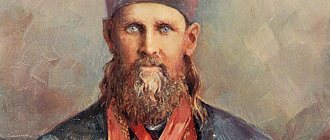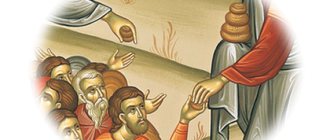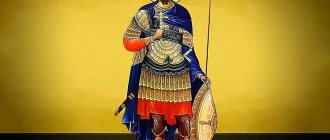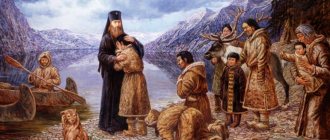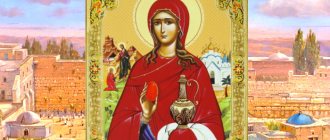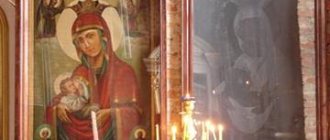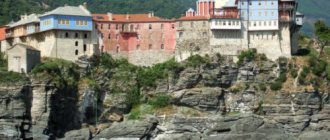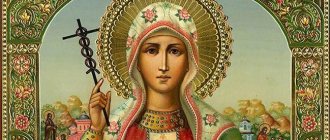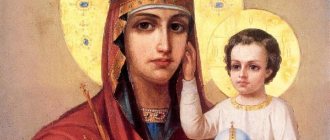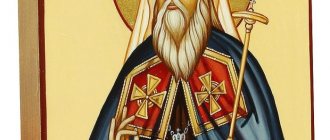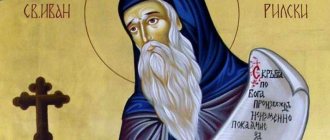Childhood and youth of Saint Righteous John of Kronstadt
There were many priests in the family of John of Kronstadt. He himself was born on October 19, 1829, in the Arkhangelsk province, in the village of Sura, Pinega district, in a Christian family. The family did not have much wealth, but they were distinguished by their zeal for God and piety. John's father, Ilya Sergiev, served as a psalmist in a local church. His wife, Theodora, mother of John, stood out for her simplicity of character and deep faith.
John was born sickly and very weak: so much so that his parents, worried about his life, were forced to rush into baptism. The name was chosen in honor of St. John of Rila. After Baptism, the boy began to recover, gain strength and get stronger.
It is noted that even in childhood he witnessed a miracle: one day John saw a luminous angel in the upper room, who, seeing the child’s confusion, calmed him down and informed him that he was his Guardian Angel and would protect him until the end of his earthly days.
In the sixth year of his life, with the help of his parents, John began to learn to read. His father often took him to church and introduced him to the services and liturgical books. Over time, John became imbued with their spirit and content. They say that from childhood, the villagers noticed in him a special disposition towards God.
When the boy grew up, his parents, having difficulty raising the necessary amount, enrolled him in the Arkhangelsk Parish School. At that time he was about ten years old. At first, learning was not easy: it was not possible to properly understand and remember the material being taught. This greatly saddened young John: on the one hand, he was and was known to be lagging behind, and on the other, he understood how difficult it was for his poor parents to pay for his stay at the school.
One day, after a heartfelt prayer before going to bed, John, according to his personal confession, felt as if he had been shaken, as if a curtain had fallen from his eyes and his mind had opened; the teacher and the lesson clearly appeared to him; he remembered its contents. In that fervent prayer, he asked God for help, and God answered him. Then his soul was filled with joy, and he fell asleep as peacefully as he had never slept before. At dawn, getting out of bed, John picked up the books and began to read. And, lo and behold, he suddenly noticed that an internal transformation had occurred in him: he easily absorbed and remembered what he read.
Since then, when attending lessons, he both felt and behaved completely differently: he understood the educational material well, answered well. Gradually, John moved from the last disciples to the best. Upon completion of the course, he was transferred to the seminary, and upon completion, in 1851, he entered the St. Petersburg Theological Academy at public expense.
While studying at the Academy, his father died. The plight in which the family found itself after the death of the breadwinner weighed heavily on John. Feeling pity and his personal responsibility to his mother, John began to look for possible income and found it. Knowing about his limited circumstances and good handwriting, they met him halfway, offering him a position as a clerk. For this work, John received up to ten rubles monthly. Sending money to his mother, he was sincerely glad that he could support her.
One day, coming home after a walk in the academic garden, John fell asleep and saw in a dream that he was a priest and served in a cathedral, which he had never been to before. Soon what he saw in the mysterious dream came true in reality.
The miraculous gift of miraculous healings
Father John of Kronstadt at his homeland in the Arkhangelsk province.
Photo from the website pravoslavie.ru Such an unusual pastoral feat of a very young priest began to cause criticism and even attacks from all sides. Many in the church community for a long time did not recognize the sincerity of his mood, mocked him, slandered him verbally and in print, and called him a holy fool.
At one time the diocesan authorities forbade even the extradition of Fr. John had the salary in his hands, since, having received it, he gave everything to the poor to the last penny, and was called for an explanation.
All these trials and mockery of Fr. John endured them courageously and patiently, understanding, as a person experienced in spiritual life, where they come from. I prayed for those who offended me according to the commandment of Christ: pray for those who offend and persecute you. And he did not change his accepted way of life in any way.
Time passed, and those who in the first years of shepherding laughed at the righteous man, slandered and persecuted him, began to glorify him, because it became clear: this is not “some kind of renovationist,” but a real shepherd, laying down his life for his sheep.
“We must love every person both in his sin and in his shame,” said Fr. John, “there is no need to confuse man—this image of God—with the evil that is in him.”
With such a consciousness, he went to people, defeating everyone and reviving everyone with the power of compassionate love.
Soon opened in o. John and the gift of miracles, which glorified him throughout Russia and far beyond its borders.
The non-believing part of society, among which there were many intelligentsia, who, due to a tragic misunderstanding, were generally not disposed towards Fr. John, the press deliberately suppressed miraculous cases of manifestation of God's mercy through the prayers of the righteous priest. But still, many miracles were recorded.
An exact recording of the story of Fr. himself has been preserved. John about the first such miracle. “Someone in Kronstadt fell ill. They asked for my prayer help. Even then I already had this habit: never refuse anyone’s request. I began to pray, committing the sick man into the hands of God, asking the Lord to fulfill His holy will over him.
Holy Righteous John of Kronstadt surrounded by people Photo from the site rg.ru
But suddenly I suddenly see an old woman whom I have known for a long time coming to me. She was a deeply religious person, who spent her life as a Christian and ended her earthly journey in the fear of God. She comes to me and insistently demands that I pray specifically for the recovery of the sick person.
I remember then I was almost afraid: “How can I,” I thought, “have such boldness?” However, this old woman firmly believed in the power of my prayer and stood her ground. Then I confessed my insignificance and my sinfulness before the Lord, having seen the will of God in this matter, and began to ask for healing for the pain.
And the Lord sent him His mercy - he recovered. I thanked the Lord for this mercy. Another time, through my prayer, the healing was repeated. Then in these two cases I already directly discerned the will of God, a new obedience from God - to pray for those who would ask for it.”
And through the prayer of Fr. John actually happened - and now after his blessed death - many miracles continue to happen. They were healed by prayer and the laying on of hands by Fr. John the most serious illnesses, when medicine was lost in its helplessness.
Healings were performed both in private and in front of a large crowd of people, and very often in absentia. It was enough to write a letter to Fr. John or send a telegram so that he would pray, and the miracle of healing would take place.
A particularly remarkable miracle happened before everyone’s eyes in the village of Konchanskoye (Suvorovskoye), described by the Suvorov Commission of Military Academy professors who happened to be there (in 1901): she had suffered from demonic possession for many years and was brought to Fr. John, in an unconscious state, a woman was healed by him a few moments later and brought into the state of a completely healthy person.
Through the prayer of Fr. John made the blind see. The artist Zhivotovsky described the miraculous shedding of rain in an area suffering from drought and forest fires after Fr. John offered his prayer there.
Father John healed with his prayer not only Russian Orthodox people, but also Muslims, Jews, and foreigners who turned to him from abroad.
This great gift was the reward of Fr. John for his exploits - prayerful works, fasting and selfless deeds of love for God and neighbors.
The priestly feat of Father John of Kronstadt
In 1855, John graduated from the academy with a candidate's degree in theology.
Due to the fact that he united himself in marriage with the daughter of Archpriest K. Nesvitsky, who served in the Kronstadt St. Andrew's Cathedral, he was invited to take the place of a clergyman in the same church. On December 10, 1855, John was ordained a deacon, and already on December 12, the same year, a priest. Having visited the cathedral for the first time, he recognized it as the one he had seen in his dream. The pastoral life of Father John took place during a difficult time for the country, marked by a massive weakening of faith, the beginning of rebellious sentiments, and the fermentation of revolutionary ideas. The city of Kronstadt served at that time as a concentration place for people expelled from the capital. Vagrancy, idle wandering, constant drunkenness, begging, extreme poverty - these are just a few aspects of the social stratum that made up a significant part of his flock and needed special attention and care. Great were the difficulties that lay before the shepherd, but great was also the sense of pastoral duty, great love for God, mercy and compassion for others.
The married life of Father John developed like this: having announced to his wife his desire to preserve virginity and by agreement with her, he lived with Elizabeth as brother and sister. Until the end of his life, John maintained chaste purity.
Initially, many did not understand and did not even accept the impulses of the extraordinary shepherd. But over time, seeing his kindness and patience, seeing his diligence and, not least, the material assistance that he provided to those in need, people began to realize: God had given them a kind and heartfelt mentor, a sensitive, responsive, wise trustee. They say that while visiting dugouts, huts and poor apartments, the monk distributed his salary, nursed children while mothers did housework, looked after the sick, could give boots and clothes to the poor, and at the same time prayed, exhorted, encouraged, and consoled.
The selflessness and mercy of Father John reached the point that he himself was left without funds. Seeing such an unprecedented state of affairs, many, some out of envy, some out of stupidity or hardness of heart, reproached the saint for insincerity, pandering to parasites and deceivers, slandered, scolded, mocked, not only verbally, but also through the press. Due to the striking dissimilarity of John of Kronstadt to many other shepherds of the Church, he was, among other things, accused of foolishness.
With the support of the diocesan authorities, his colleagues ensured that the priest’s salary was received by his wife. But the Wise Lord did not leave him without the opportunity to help the hunger. He kept the payment he received for teaching the Law of God at the local Kronstadt Real School to himself, and donated it to those whom he considered necessary.
Over time, the rumor about the great lamp spread so much that huge crowds of people began to flock to it, and so many messages and telegrams came to its address that the Kronstadt post office was forced to organize a special department to process its correspondence. They wrote to John not only from different parts of the state, but also from abroad. In order to carefully analyze all these messages, he was forced to resort to the help of secretaries.
Along with those seeking soul-saving benefits, material resources also flocked to John. One can only guess about the size of the sums of money at his disposal: he immediately donated them to charity and distributed them to the poor. They say that it happened when they handed him an envelope, he immediately, without opening it, gave it to someone.
Father served in St. Andrew's Cathedral in Kronstadt for 56 years
During all the years of his priestly service, Fr. John celebrated the Divine Liturgy in the cathedral almost every day, and in the last 35 years of his life he served daily (last time - December 10, 1908).
Father John got up very early. Having gotten up, he began to prepare for the Divine Liturgy. When he went to the temple, he was met by crowds of believers eager to receive the blessing. There were also beggars present, whom he gave alms to.
During the morning service, Father John himself read the canon, carefully and attentively, attaching high importance to this reading. Before the start of the Liturgy, Confession took place. Over time, due to the huge crowd of people, both local and pilgrims, who certainly wanted to confess to John of Kronstadt, he was forced to introduce general confession into his practice (according to various estimates, St. Andrew’s Cathedral accommodated 5-7 thousand people). They say that this sacred rite made an indelible impression on participants and eyewitnesses. Inspired, shocked by the pastor's word and jealousy, people loudly shouted out their sins, including the most vile ones, and repented out loud, as if not ashamed of the witnesses crowding them on all sides. It is said that as a result, believers actually experienced a sense of liberation from the burden of sin. The service was characterized by a single, fiery, prayerful impulse.
After about seventeen years of pastoral service, the Lord vouchsafed Father John to organize a special institution in Kronstadt - the “House of Diligence.” On this occasion, he addressed the people with an appeal, proposing to carry out this godly deed through joint efforts. The appeal was published. The response was sincere and widespread. The foundation stone for the building took place on August 23, 1881, and the opening took place on October 12, 1882. Gradually, the activities of the House of Industriousness developed, positively affecting the interests of different social groups and strata. At the House of Industriousness there were workshops, a public canteen, a school, shelters, a library, and a reading room.
The role of John of Kronstadt in relation to women's hermitages and monasteries is also worthy of admiration. In particular, with his direct participation, a convent for women was founded in his native village, as well as in St. Petersburg on Karpovka. He supported many monasteries, contributing to their expansion, blessing the entry of sisters into them, and serving in the monastery churches.
Due to the nature of his pastoral activity and at the call of his Christian heart, Father John regularly visited St. Petersburg, visiting those in need of care and the sick. In order to carry out his service to God, he traveled to remote corners of the Russian Empire. Contemporaries noted the special healing power of his prayers for the sick, his healing gift. In addition, John was awarded by God the gift of miracles and clairvoyance.
Tens of thousands with reverence and fear of God waited for their beloved priest in various places of his probable appearance. When he rode in a carriage, people were ready to rush towards him right as he went. Even the fear of being broken or maimed did not stop them. When Father John was traveling on a ship, the believers ran after the ship along the shore, many knelt down. In addition, the saint found respect at the royal court. Another would seem to have broken down and become proud under the onslaught of collapsing glory. But not Father John, a true warrior of Christ, a lover of God. Just as the temptations of attacks and slander could not break his steadfastness, so the temptation of fame could not blacken his meek, humble attitude.
“Love us little blacks”
On the left - with his wife Elizaveta Konstantinovna, 1890s.
On the right - with his own nephew Igor Shemyakin, before 1900. The photographs were taken in the village of Martyshkino, St. Petersburg province. From the fund of TsGAKFFD St. Petersburg. Website: spbarchives.ru Married to his wife, Fr. John lived like brother and sister, remaining a virgin. According to his ideas, this seemed necessary for a servant of God who strives to devote himself entirely to the Church and people.
“There are many happy families, Lisa, even without us. And you and I, let’s devote ourselves to serving God,” he said to his wife on the first day of their marriage.
Carefully hiding his asceticism from people, Fr. John was the greatest ascetic. His amazingly sincere diary “My Life in Christ” is an honest testimony of the struggle with sinful thoughts, mistakes and their experiences, and the most ardent self-condemnation.
At the heart of all the asceticism of the “secular priest” Fr. John had, firstly, reckless and devoted faith and love for God. Love and compassion for people, pity for them and prayer for them were based on this faith and love.
Strict fasting, both mental and physical, was required from Fr. John and the daily celebration of the Divine Liturgy, which he set as a rule.
At the first meeting with his flock, Fr. John saw that here he would have no less work for missionary work than in distant pagan countries. In Kronstadt - the place of administrative expulsion of vicious people from the capital St. Petersburg - unbelief, heterodoxy and sectarianism reigned.
Many laborers also lived there, working mainly in the port. They all lived, for the most part, in miserable shacks and dugouts, begging and drinking. City residents suffered a lot from these degenerate people, who were called “posadskys.” It was not always safe to walk through the streets at night—there were attacks.
It was to these “lost” people, despised by everyone, that Fr. turned his main attention. John. He is not limited to preaching from the pulpit and passionate calls to “live correctly.” He goes to the homes of the “lost”, talks, consoles, cares for the sick, helps financially, giving away everything he has, sometimes returning home undressed and shoeless.
Kronstadt. House of Industriousness, founded by St. right John of Kronstadt. Photo from the site mir.zavantag.com
And it was these Kronstadt “tramps”, “scum of society”, who were first touched by the love of the good shepherd, who were the first to “discover” the holiness of Fr. John. And then the “discovery” was very quickly confirmed by all believers in Russia.
He spoke unusually touchingly about one of these cases of spiritual rebirth thanks to Fr. To John, one artisan: “I was then 22-23 years old. Now I’m an old man, but I remember well the first time I saw the priest.
I had a family, two children. I worked and drank. The family was starving. My wife slowly collected from all over the world. We lived in a crappy kennel. I come once, not very drunk. I see some young priest sitting, holding his little son in his arms and saying something to him affectionately. The child listens seriously. It seems that the priest was like Christ in the painting “Blessing of the Children.”
I wanted to swear: they were wandering around... but the priest’s eyes, affectionate and serious, stopped me: I felt ashamed. I lowered my eyes, and he looked - he looked straight into my soul. He started talking. I don’t dare convey everything he said.
He talked about the fact that I have paradise in my closet, because where there are children, it is always warm and good, and that there is no need to exchange this paradise for the children of the tavern. He didn’t blame me, no, he justified everything, but I had no time for justification. He left, and I sit and remain silent... I don’t cry, although my soul feels the same as before tears. My wife is watching... And since then I have become a man...".
House of Diligence of John of Kronstadt: more mercy than labor
The illness and last days of the earthly life of Father John of Kronstadt
The time of death was revealed to Father John in advance. Towards the end of his earthly life he was susceptible to bodily illnesses and began to weaken. He was tormented by severe pain, which sometimes subsided during the service of the Liturgy. On December 10, 1908, Father John, having gathered his will and strength, celebrated the last Liturgy. In the last period of his earthly life, he received communion every day at home. On December 20, 1908, at 7:40 a.m., the saint’s heart stopped, he rested peacefully in the Lord and joined eternity.
Family
After receiving higher education, the pastor of the Church married the daughter of the archpriest of the Kronstadt Cathedral, Elizabeth. They had no children, having taken upon themselves the feat of virginity, but they raised two daughters of the sister of his wife Anna. After his marriage, his wife’s widowed father, her three brothers and two sisters also found themselves in the care of the young husband.
John of Kronstadt and his wife Elizaveta Konstantinovna
Mother Elizabeth taught her nieces French, accompanied them to the gymnasium, and took care of the housework. Father John monitored their academic progress every day. According to the recollections of one of the adopted daughters, the pious spouses were distinguished by their touching care and attention to each other.
Spiritual heritage of a shepherd
During his priestly ministry, Father John delivered an innumerable number of sermons and left many written instructions. He is rightfully considered one of the best church writers.
Within the framework of moral writings, Father John assures us of the need for sincere faith, love for God and neighbor, arranging life in accordance with the way of life of Christ, a constant spiritual struggle against sinful passions and vices (see on this subject: My life in Christ; Conversations on Beatitudes of the Gospel). Father John confirmed the truth of the moral teaching taught to us by his life, the feat of pastoral and general Christian work.
The theological works of John of Kronstadt reveal a wide variety of themes in the doctrine of the Church: about God; about the salvation of man; about the veneration of the Cross (see: On the Cross of Christ), the Most Holy Theotokos and the saints; about repentance and prayer (see: Prayers of our holy righteous father John of Kronstadt the Wonderworker).
Where are the relics located and stored?
The relics are right. John of Kronstadt are kept under wraps in the Ioannovsky Monastery in St. Petersburg, at the address Embankment. Karpovki, 45. The grave is located in the monastery’s burial vault. Right John was buried in accordance with his last wishes, expressed shortly before his death.
The tomb is open daily at the end of the liturgy.
Prayer to Saint Righteous John, Presbyter of Kronstadt, Wonderworker
O great wonderworker and wonderful servant of God, God-bearing Father John! Look at us and listen compassionately to our prayer, for the Lord has vouchsafed you great gifts, so that you may become an intercessor and constant prayer-book for us. Behold, we are overwhelmed by sinful passions and consumed by malice, we have neglected the commandments of God, we have not brought heartfelt repentance and tears of sighing, for this reason we are worthy of appearing through many sorrows and sorrows. But you, righteous father, having great boldness towards the Lord and compassion for your neighbors, beg the All-Bountiful Lord of the world to add His mercy to us and tolerate our unrighteousness, not to destroy us for our sin, but to mercifully grant us time for repentance. O Saint of God, help us to immaculately observe the Orthodox faith and piously preserve the commandments of God, so that all iniquity may not possess us, the Truth of God will be put to shame in our untruths, but may we be honored to achieve a Christian death, painless, shameless, peaceful and partakers of the Mysteries of God. We also pray to you, righteous father, for our Holy Church to be strengthened until the end of time, and for our fatherland, seek peace and prosperity in the Truth of God and save us from all evils, so that our people, preserved by God, are in unanimity of faith and in all piety and In purity, in the beauty of spiritual brotherhood, sobriety and harmony, they testify: that God is with us! In Nemzhe we live, and we move, and we are, and we will abide forever. Amen.
Community service
Self-sacrifice
The city of Kronstadt at that time enjoyed a bad reputation; as they would say now, it was then a troubled place. Asocial individuals were exiled there as punishment; the city was filled with poor, unemployed people.
For such a compassionate, selfless person as Father John, there was a lot of work there. He visited the poor, helped them with money and clothing, nursed children if their mother did the laundry or cooked food, and consoled the sick.
There were even cases when he came to his home barefoot, because he gave his shoes to a beggar. There is even such an interesting fact known about this that for some time Father John’s salary was given to his wife, since he could give every penny to the poor.
Social activities about. Joanna was of great importance to people. On his initiative, the House of Diligence was founded, where people were finally able to find work in the workshops. In addition, there was a canteen and a medical facility. The successful work of such a charitable institution led to the emergence of similar ones throughout Russia.
This gave ordinary people a chance to at least slightly improve their living conditions. On his initiative, using voluntary donations, a school for children was opened, and a little later an orphanage.
Healing Sermons and Other Miracles
Father John's sermons were very different from others. His speeches to people were always very emotional, his words burned through the soul - this is what eyewitnesses said. He called for the Holy Sacraments to be performed more often, and called people to sobriety. With just his prayer he healed the sick. Descriptions of many real facts from his life have reached us, here is one of them. It was in Kharkov. One man’s daughter became very ill, and the doctors were already saying that she had only a few days to live.
At this time, Father John arrived in the city. With great difficulty, the man made his way to him and asked him to pray for his daughter. Then the priest laid his hands on his head. Returning to his home, the happy father met his already healthy, smiling daughter.
Father John performed such miracles during his lifetime, but even in our modern days, by praying to the saint, people receive answers to all their many requests: healing, help in business, support.
And this was told, at one time, by one person who, after meeting with Fr. John stopped drinking. He just opened the door of the carriage in which the famous priest arrived at the place of service. And he met his gaze.
As he later said: he was tall. He smiled, and his eyes were deep and burned with such a bright fire that I felt terrified. And he says: why, my dear, are you drinking? Since then I haven’t drunk.” That's how the man was healed.
Nowadays, the Soul Care Center named after St. John has been opened in Moscow. They organize pilgrimage trips to holy places and help people get rid of negative addictions: drunkenness, drug addiction, gambling addiction and others.
Do you know that John of Kronstadt himself smoked at one time? In the 19th century this was considered acceptable for priests. But he struggled with this habit, prayed, and was still able to get rid of it.
When popularity becomes dangerous, but necessary
Soon Father John became so popular and famous among both ordinary and rich people that this began to annoy him. He could not walk freely along the street, since everywhere he was immediately surrounded by people to make a request.
For example, one incident occurred, after which it became clear that such incredible fame was unsafe. This happened in Riga. As the preacher walked through the city, he was surrounded by many people. And the crowd, literally, tore his cassock. Each of them wanted to take at least a piece of the miracle worker’s clothing.
But there was good in such national fame. Rich people did not skimp on donations, and I. Kronstadt received huge sums of money. But he did not take this money for himself. With these contributions he built schools, hospitals, and churches.
Almost every year Ioann Sergiev (this is the real name of I. Kronstadt) came to the village of Sura, his homeland.
There, with his money, a parish church was built, and a monastery for women was founded.
The popularity and fame of Father John spread far around, and he was invited to Crimean Livadia, where the sick Emperor Alexander 3 lay. At the request of the king, the monk anointed him with oil and laid his hands on his head.
Later, Father John attended the coronation ceremony of the next Russian Tsar, Nicholas 2.
Confrontation: John and Leo
In his notes, Father John strongly criticized the very influential and popular Leo Tolstoy at that difficult time, accusing him of “hereticy” and the creation of false teaching, which, as he believed, would lead to the death of the country.
He predicted the sinner, as he called Tolstoy, a fierce death. And some argue that this was so, because for a long time before his death, Count Tolstoy suffered from terrible nightmares that he saw.
Second prayer
Oh, holy and righteous Father John, All-Russian lamp and wonderful miracle worker! From your infancy you were chosen by God and, with a fiery spirit, like a true shepherd, you served the people in your life, in your words, in your love, in your faith, in your purity. For this reason, we pray to you, righteous father: pray to God, the Lover of Mankind, to protect the holy Church with peace and silence, to preserve the Russian land in prosperity, to fill the shepherds of grace and truth abundantly, to make the authorities wise, to strengthen the Orthodox army, to heal the weak, to correct the corrupt, to educate the young, the elders and widows to console us all in the Kingdom of Heaven to be honored with all the saints to glorify the Father and the Son and the Holy Spirit, now and ever and unto ages of ages. Amen.
Prayer three
O great servant of Christ, holy and righteous Father John of Kronstadt, wondrous shepherd, quick helper and merciful representative! Raising praise to the Triune God, you prayerfully cried out: Your name is Love: do not reject me, the erring one. Your name is Strength: strengthen me, who is weak and falling. Your name is Light: enlighten my soul, darkened by worldly passions. Your name is Peace: pacify my restless soul. Your name is Mercy: do not cease to have mercy on me. Now, grateful to your intercession, the all-Russian flock prays to you: Christ-named and righteous servant of God! With your love, illumine us, sinners and weaklings, grant us the ability to bear worthy fruits of repentance and to partake of the Holy Mysteries of Christ without condemnation. By your power, strengthen our faith in us, support us in prayer, heal ailments and illnesses, deliver us from misfortunes, enemies, visible and invisible. With the light of your face, incite the servants and primates of the Altar of Christ to holy deeds of pastoral work, grant education to an infant, instruct youth, support old age, illuminate the shrines of churches and holy abodes! Die, most miraculous and visionary, the peoples of our country, by the grace and gift of the Holy Spirit, deliver from internecine warfare, gather the scattered, deceived converts and unite the Holy Catholic and Apostolic Church. By your grace, preserve marriage in peace and unanimity, grant prosperity and blessings to monastics in good deeds, give comfort to the faint-hearted, freedom to those suffering from unclean spirits, have mercy in the needs and circumstances of our lives, and guide us all on the path of salvation. In Christ living, our Father John, lead us to the Everlasting Light of eternal life, so that with you we may be worthy of eternal bliss, praising and exalting God forever and ever. Amen.
Real examples of miracles
In the Ioannovsky Monastery, a record of modern miracles of the Kronstadt shepherd is kept.
This is help in everyday affairs, spiritual support. But the healings are especially numerous.
Healing Cancer
In 1990, Valentina, who lived next to the monastery, was diagnosed with stage 4 cancer. The patient was discharged home. In search of consolation, she came to the monastery. The journey took an hour and a half, the patient was so weak.
The priest told her about the need for confession and Communion. The woman began to go to the monastery every day, prepare for death, and comprehend life. And after a month of such spiritual work, doctors stated “spontaneous remission.” The disease is gone.
